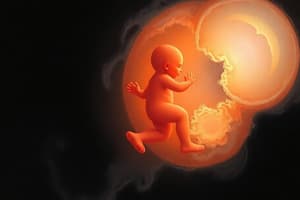Podcast
Questions and Answers
What is the primary purpose of ultrasound scans during pregnancy?
What is the primary purpose of ultrasound scans during pregnancy?
- To check for the baby's position and health (correct)
- To measure maternal blood pressure
- To facilitate fertilization of the egg
- To determine the gender of the baby
What is the term used for the time from fertilization to birth?
What is the term used for the time from fertilization to birth?
- Implantation period
- Germination phase
- Gestation (correct)
- Conception duration
Which structure connects the fetus to the placenta?
Which structure connects the fetus to the placenta?
- Amniotic sac
- Fetal membranes
- Umbilical cord (correct)
- Uterine wall
What early developmental milestone occurs at 4 weeks of gestation?
What early developmental milestone occurs at 4 weeks of gestation?
How do sperm cells reach the egg during fertilization?
How do sperm cells reach the egg during fertilization?
What significant impact can alcohol consumption have during pregnancy?
What significant impact can alcohol consumption have during pregnancy?
Which of the following is NOT a function of the placenta?
Which of the following is NOT a function of the placenta?
During the birth process, what happens immediately after the baby is delivered?
During the birth process, what happens immediately after the baby is delivered?
Flashcards
Fertilization
Fertilization
The process where a sperm cell and an egg cell fuse to form a zygote, marking the beginning of a new life.
Implantation
Implantation
Attachment of the fertilized egg to the lining of the uterus, allowing for the embryo's development.
Sperm Journey
Sperm Journey
The journey of sperm from ejaculation to fertilization. It involves swimming through the vagina and uterus, reaching the fallopian tube.
Umbilical Cord
Umbilical Cord
Signup and view all the flashcards
Amniotic Fluid
Amniotic Fluid
Signup and view all the flashcards
Birth Process
Birth Process
Signup and view all the flashcards
Placenta
Placenta
Signup and view all the flashcards
Placental Blood
Placental Blood
Signup and view all the flashcards
Study Notes
Fertilization and Development
- Fertilization occurs when sperm and egg nuclei unite, forming a zygote.
- Implantation is when the fertilized egg attaches to the uterine lining.
- Gestation is the period from fertilization to birth, typically 9 months (40 weeks).
- Ultrasound scans are used to monitor fetal growth, detect abnormalities, and assess position/health.
Sperm's Journey to the Egg
- Ejaculation releases sperm into the vagina.
- Sperm swim through the vagina, cervix, and into the uterus.
- Sperm reach the oviduct (fallopian tube), where fertilization may occur.
- Fertilization happens when a sperm successfully meets an egg in the oviduct.
Fetal Development Stages
- 1 Week: Cell specialization begins.
- 4 Weeks: Spine, brain, and heart formation start; heart begins beating.
- 9 Weeks: Fetal movement (e.g., kicking, swallowing); touch sensitivity develops; eyes and ears form.
- 12 Weeks: Muscle use (kicking, swallowing); practicing breathing.
Support Systems
- Placenta: Facilitates nutrient and waste exchange between mother and fetus; acts as a barrier to infections.
- Umbilical Cord: Connects the fetus to the placenta.
- Amniotic Fluid: Cushions and protects the fetus.
Factors Affecting Development
- Smoking: Leads to premature birth.
- Alcohol: Damages brain development.
- Drugs: Impair fetal growth and organ formation.
Birth Process
- Uterine contractions expel the baby through the vagina.
- The umbilical cord is cut after birth.
- The placenta is delivered as the afterbirth.
Fetal Nutrition and Development
- The fetus receives nutrients and oxygen via the placenta and maternal blood circulation.
- The spine, brain, and heart develop early in fetal life.
- The sperm travels through the vagina, cervix, and uterus to reach the oviduct for fertilization.
- The placenta facilitates nutrient exchange and acts as an infection barrier. The umbilical cord connects the fetus to the placenta.
Studying That Suits You
Use AI to generate personalized quizzes and flashcards to suit your learning preferences.




